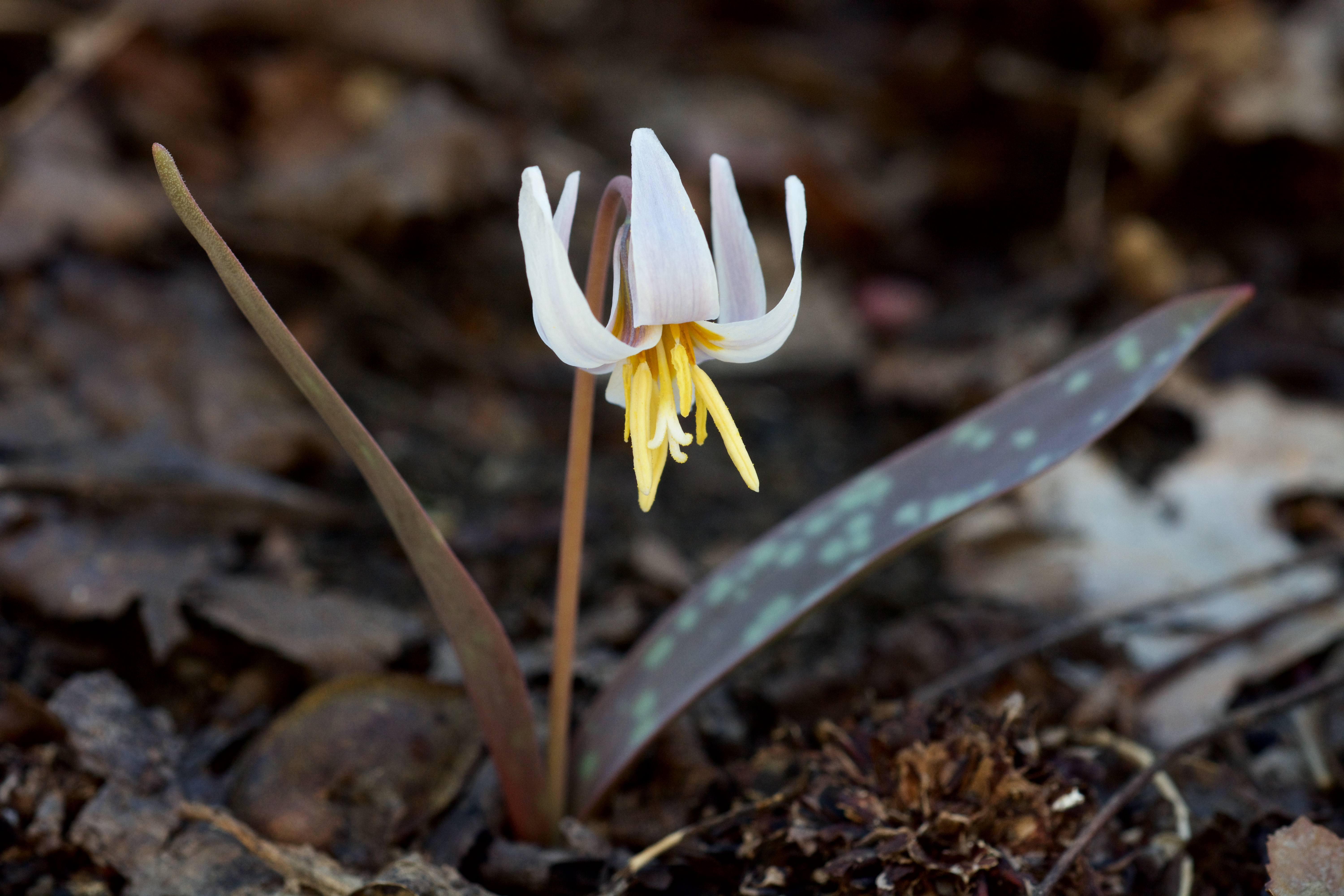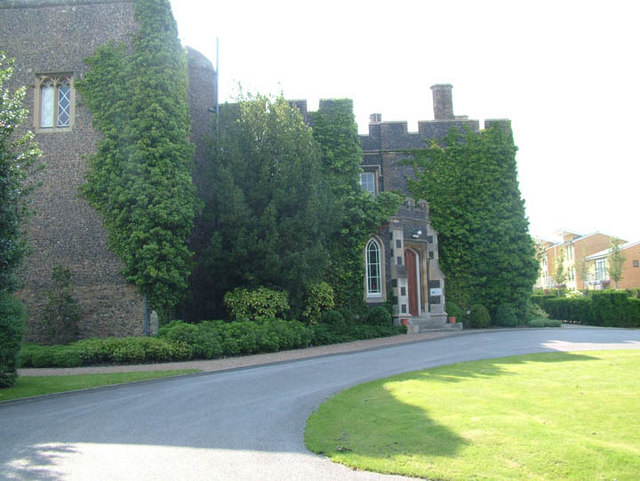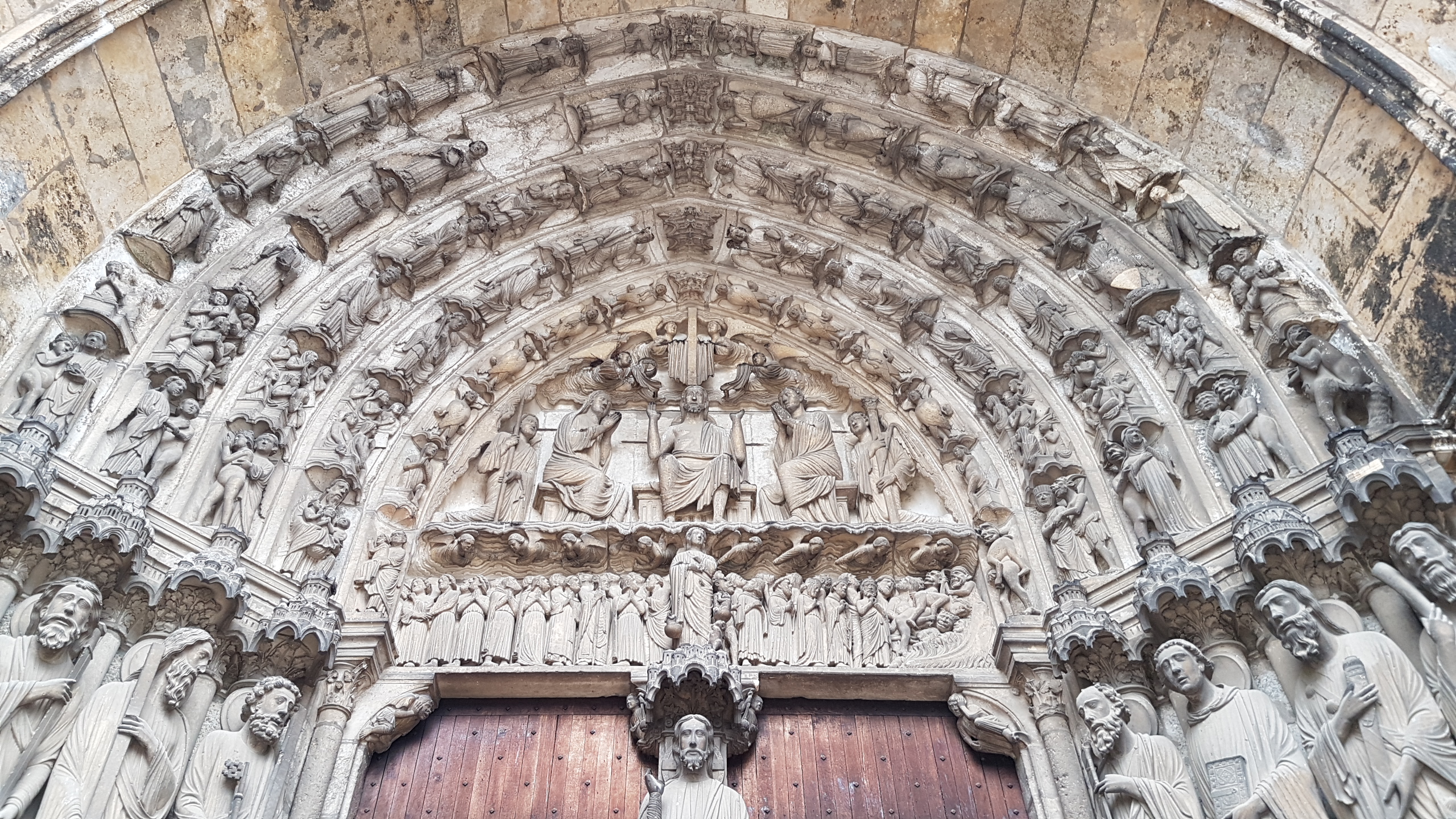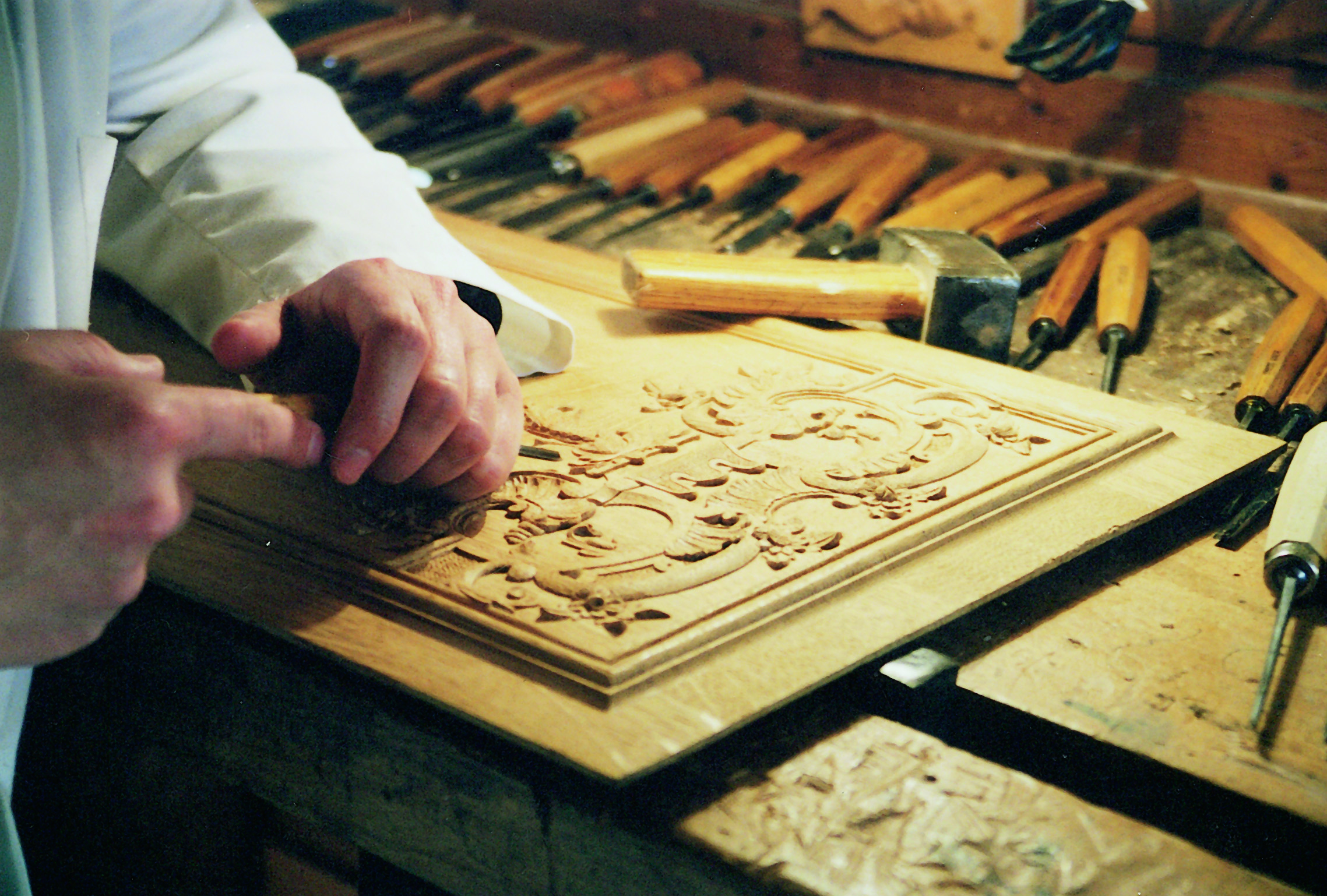|
Dog-tooth
In architecture, a dog-tooth or dogtooth pattern is an ornament found in the mouldings of medieval work of the commencement of the 12th century, which is thought to have been introduced by the Crusaders. The earliest example is found in the hall at Rabbath Ammon in Moab in Jordan (c. 614) built by the Sassanians, where it decorates the arch moulding of the blind arcades and the string courses. The pattern consists of four flower petals forming a square or diamond shape with central elements. The petals have the form of the pointed conical canine tooth, eye tooth or cuspid. In the apse of a church at Murano, near Venice, it is similarly employed. In the 12th and 13th centuries it was further elaborated with carving, losing therefore its primitive form, but constituting a most beautiful decorative feature. In Elgin Cathedral in Scotland, the dogtooth ornament in the archivolt becomes a four-lobed leaf, and in Stone church in Kent, a much more enriched type of flower. The term ha ... [...More Info...] [...Related Items...] OR: [Wikipedia] [Google] [Baidu] |
Venice
Venice ( ; ; , formerly ) is a city in northeastern Italy and the capital of the Veneto Regions of Italy, region. It is built on a group of 118 islands that are separated by expanses of open water and by canals; portions of the city are linked by 438 bridges. The islands are in the shallow Venetian Lagoon, an enclosed bay lying between the mouths of the Po River, Po and the Piave River, Piave rivers (more exactly between the Brenta (river), Brenta and the Sile (river), Sile). As of 2025, 249,466 people resided in greater Venice or the Comune of Venice, of whom about 51,000 live in the historical island city of Venice (''centro storico'') and the rest on the mainland (''terraferma''). Together with the cities of Padua, Italy, Padua and Treviso, Italy, Treviso, Venice is included in the Padua-Treviso-Venice Metropolitan Area (PATREVE), which is considered a statistical metropolitan area, with a total population of 2.6 million. The name is derived from the ancient Adr ... [...More Info...] [...Related Items...] OR: [Wikipedia] [Google] [Baidu] |
Dentil
A dentil (from Lat. ''dens'', a tooth) is a small block used as a repeating ornament in the bedmould of a cornice. Dentils are found in ancient Greek and Roman architecture, and also in later styles such as Neoclassical, Federal, Georgian Revival, Greek Revival, Renaissance Revival, Second Empire, and Beaux-Arts architecture. Dentillation refers to use of a course of dentils. History Origin The Roman architect Vitruvius (iv. 2) states that the dentil represents the end of a rafter (''asser''). It occurs in its most pronounced form in the Ionic temples of Asia Minor, the Lycian tombs, and the porticoes and tombs of Persia, where it clearly represents the reproduction in stone of timber construction. The earliest example is found carved into the rock of the tomb of Darius, c. 500 BC, reproducing the portico of his palace. Its first employment in Athens is in the cornice of the caryatid portico of the Erechtheum (480 BC). When subsequently introduced into the bed-mould of the ... [...More Info...] [...Related Items...] OR: [Wikipedia] [Google] [Baidu] |
Ball Flower
A ball is a round object (usually spherical, but sometimes ovoid) with several uses. It is used in ball games, where the play of the game follows the state of the ball as it is hit, kicked or thrown by players. Balls can also be used for simpler activities, such as catch or juggling. Balls made from hard-wearing materials are used in engineering applications to provide very low friction bearings, known as ball bearings. Black-powder weapons use stone and metal balls as projectiles. Although many types of balls are today made from rubber, this form was unknown outside the Americas until after the voyages of Columbus. The Spanish were the first Europeans to see the bouncing rubber balls (although solid and not inflated) which were employed most notably in the Mesoamerican ballgame. Balls used in various sports in other parts of the world prior to Columbus were made from other materials such as animal bladders or skins, stuffed with various materials. As balls are one of the m ... [...More Info...] [...Related Items...] OR: [Wikipedia] [Google] [Baidu] |
Tooth
A tooth (: teeth) is a hard, calcified structure found in the jaws (or mouths) of many vertebrates and used to break down food. Some animals, particularly carnivores and omnivores, also use teeth to help with capturing or wounding prey, tearing food, for defensive purposes, to intimidate other animals often including their own, or to carry prey or their young. The roots of teeth are covered by gums. Teeth are not made of bone, but rather of multiple tissues of varying density and hardness that originate from the outermost embryonic germ layer, the ectoderm. The general structure of teeth is similar across the vertebrates, although there is considerable variation in their form and position. The teeth of mammals have deep roots, and this pattern is also found in some fish, and in crocodilians. In most teleost fish, however, the teeth are attached to the outer surface of the bone, while in lizards they are attached to the inner surface of the jaw by one side. In cartila ... [...More Info...] [...Related Items...] OR: [Wikipedia] [Google] [Baidu] |
Erythronium
''Erythronium'', the fawn lily, trout lily, dog's-tooth violet or adder's tongue, is a genus of Eurasian and North American plants in the Liliaceae, lily family, most closely related to tulips. The name Erythronium derives from Ancient Greek () "red" in Greek, referring to the red flowers of Erythronium dens-canis, ''E. dens-canis''. Of all the established species, most live in North America; only six species are found in Europe and Asia. Taxonomy It was published by Carl Linnaeus in 1753Linné, Carl von, & Salvius, Lars. (1753). Caroli Linnaei ... Species plantarum :exhibentes plantas rite cognitas, ad genera relatas, cum differentiis specificis, nominibus trivialibus, synonymis selectis, locis natalibus, secundum systema sexuale digestas... (Vol. 1, p. 305). Impensis Laurentii Salvii. https://www.biodiversitylibrary.org/page/358324 with ''Erythronium dens-canis'' as the type species. Species ''Erythronium'' includes about 20–30 species of Hardiness (plants), hardy spr ... [...More Info...] [...Related Items...] OR: [Wikipedia] [Google] [Baidu] |
Flower
Flowers, also known as blooms and blossoms, are the reproductive structures of flowering plants ( angiosperms). Typically, they are structured in four circular levels, called whorls, around the end of a stalk. These whorls include: calyx, modified leaves; corolla, the petals; androecium, the male reproductive unit consisting of stamens and pollen; and gynoecium, the female part, containing style and stigma, which receives the pollen at the tip of the style, and ovary, which contains the ovules. When flowers are arranged in groups, they are known collectively as inflorescences. Floral growth originates at stem tips and is controlled by MADS-box genes. In most plant species flowers are heterosporous, and so can produce sex cells of both sexes. Pollination mediates the transport of pollen to the ovules in the ovaries, to facilitate sexual reproduction. It can occur between different plants, as in cross-pollination, or between flowers on the same plant or even the same f ... [...More Info...] [...Related Items...] OR: [Wikipedia] [Google] [Baidu] |
Stone, Kent
Stone, also known as Stone-next-Dartford, is a village and civil parish in the Borough of Dartford in Kent, England, about 3 km east of Dartford and 27 kilometres from central London. It lies on the south bank of the River Thames. The A226 road, A226 (London Road) runs through Stone, linking Dartford with Greenhithe, Kent, Greenhithe and Gravesend; the A2 (Roman Watling Street) and M25 motorway pass just north of the parish. The area of Stone includes part of the Bluewater Shopping Centre. The parish population was 10,778 in the 2011 census, rising to about 12,890 by 2021. History Stone has evidence of a very early settlement. Numerous Palaeolithic flint tools and handaxes have been found in the parish (for example at Crossways Business Park), reflecting human activity up to one million years ago. In nearby Swanscombe (just east of Stone) pieces of a 400,000-year-old human skull were discovered along with Acheulean (handaxe) tools – some of the earliest human remains in Euro ... [...More Info...] [...Related Items...] OR: [Wikipedia] [Google] [Baidu] |
Leaf
A leaf (: leaves) is a principal appendage of the plant stem, stem of a vascular plant, usually borne laterally above ground and specialized for photosynthesis. Leaves are collectively called foliage, as in "autumn foliage", while the leaves, stem, flower, and fruit collectively form the Shoot (botany), shoot system. In most leaves, the primary Photosynthesis, photosynthetic Tissue (biology), tissue is the palisade mesophyll and is located on the upper side of the blade or lamina of the leaf, but in some species, including the mature foliage of ''Eucalyptus'', palisade mesophyll is present on both sides and the leaves are said to be isobilateral. The leaf is an integral part of the stem system, and most leaves are flattened and have distinct upper (Glossary of botanical terms#adaxial, adaxial) and lower (Glossary of botanical terms#abaxial, abaxial) surfaces that differ in color, Trichome, hairiness, the number of stomata (pores that intake and output gases), the amount and ... [...More Info...] [...Related Items...] OR: [Wikipedia] [Google] [Baidu] |
Archivolt
An archivolt (or voussure) is an ornamental Molding (decorative), moulding or band following the curve on the underside of an arch. It is composed of bands of ornamental mouldings (or other architectural elements) surrounding an arched opening, corresponding to the architrave in the case of a rectangular opening. The word is sometimes used to refer to the under-side or inner curve of the arch itself (more properly, the ''intrados''). Most commonly archivolts are found as a feature of the arches of church Portal (architecture), portals. The mouldings and sculptures on these archivolts are used to convey a Theology, theological story or depict religious figures and ideologies of the church in order to represent the gateway between the Sacredness, holy space of the church and the external world. The presence of archivolts on churches is seen throughout history, although their design, both architecturally and artistically, is heavily influenced by the period they were built in and th ... [...More Info...] [...Related Items...] OR: [Wikipedia] [Google] [Baidu] |
Elgin Cathedral
Elgin Cathedral, a historic ruin in Elgin, Moray, northeast Scotland, was dedicated to the Holy Trinity. It was established in 1224 on land granted by King Alexander II of Scotland, Alexander II and stood outside the burgh of Elgin, close to the River Lossie. It replaced the cathedral at Spynie Cathedral, Spynie located to the north, which was served by a small chapter (religion), chapter of eight clerics. By 1226, the new and developing cathedral was staffed with 18 canon (priest), canons, a number that increased to 23 by 1242. A damaging fire in 1270 led to significant enlargement. It remained unscathed during the Wars of Scottish Independence but suffered extensive fire damage in 1390 when attacked by Robert III of Scotland, Robert III's brother Alexander Stewart, Earl of Buchan, also known as the Wolf of Badenoch. In 1402, the cathedral precinct faced another incendiary attack by the Lord of the Isles followers. As the cathedral grew, so did the number of clerics and craf ... [...More Info...] [...Related Items...] OR: [Wikipedia] [Google] [Baidu] |
Wood Carving
Wood carving (or woodcarving) is a form of woodworking by means of a cutting tool (knife) in one hand or a chisel by two hands or with one hand on a chisel and one hand on a mallet, resulting in a wooden figure or figurine, or in the sculpture, sculptural ornamentation of a wooden object. The phrase may also refer to the finished product, from individual sculptures to hand-worked mouldings composing part of a tracery. The making of sculpture in wood has been History of wood carving, extremely widely practised, but does not survive undamaged as well as the other main materials like Stone sculpture, stone and bronze, as it is vulnerable to decay, insect damage, and fire. Therefore, it forms an important hidden element in the art history of many cultures. Outdoor wood sculptures do not last long in most parts of the world, so it is still unknown how the totem pole tradition developed. Many of the most important sculptures of China and Japan, in particular, are in wood, and so are th ... [...More Info...] [...Related Items...] OR: [Wikipedia] [Google] [Baidu] |







